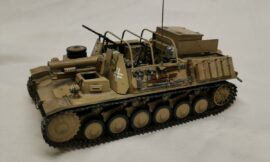The Elefant, originally known as the Ferdinand, was a heavy tank destroyer used by Germany during World War II. It was developed in response to the heavy losses suffered by German armored forces on the Eastern Front, particularly during the Battle of Kursk in 1943. The Elefant was built on the chassis of the Porsche-designed Tiger (P) prototype and armed with a powerful 8.8 cm Pak 43/2 L/71 gun, making it highly effective against Soviet tanks at long ranges.
Development and Design
The development of the Elefant began after the Battle of Kursk in 1943, where the existing Ferdinand tank destroyers (later renamed Elefant) suffered from mechanical breakdowns and vulnerability to infantry attacks due to the lack of secondary armament. The chassis of the Porsche-designed Tiger (P) prototype, which had been rejected in favor of the Henschel-designed Tiger I, was used as the basis for the new tank destroyer.
The Elefant featured a heavily armored casemate superstructure, which housed the main armament, the 8.8 cm Pak 43/2 L/71 gun. This gun was a variant of the powerful 8.8 cm gun used on the Tiger II tank and had excellent armor-piercing capabilities, capable of penetrating thick armor at long ranges. The superstructure was well-armored, with frontal armor up to 200 mm thick, providing protection against most Allied anti-tank weapons.
Armament and Capabilities
The main armament of the Elefant was the 8.8 cm Pak 43/2 L/71 gun. This gun had a long barrel and high muzzle velocity, allowing it to effectively engage and destroy Soviet tanks such as the T-34 and KV series from long distances. The Elefant carried around 50 rounds of ammunition for the main gun, which included armor-piercing shells for engaging tanks and high-explosive rounds for anti-personnel and anti-structure roles.
Secondary armament included one or two MG 34 or MG 42 machine guns for defense against infantry and light vehicles, although the Elefant was primarily intended for long-range engagements rather than close combat.
Mobility and Performance
The Elefant was powered by two Maybach HL 120 TRM engines, each producing 300 horsepower. This provided a total of 600 horsepower, which allowed the Elefant to reach a top speed of around 30 km/h (19 mph) on roads and approximately 15 km/h (9 mph) off-road. Its operational range was limited to approximately 150 kilometers (93 miles) on a full tank of fuel, which, coupled with its heavy weight of around 65 metric tons, restricted its mobility in rough terrain.
Operational History
The Elefant saw its first combat deployment during the Battle of Kursk in July 1943, where it was used as part of the German armored forces’ defensive operations against the Soviet offensive. Despite its powerful armament and heavy armor, the Elefant faced numerous challenges on the battlefield, including mechanical breakdowns, limited mobility, and vulnerability to infantry attacks due to the lack of secondary armament.
Following its initial deployment, the surviving Elefants were withdrawn from the front lines and underwent modifications to improve reliability and address design flaws. Some Elefants were later used in defensive operations on the Italian Front and in Hungary, where their firepower and armor protection were valued in static defensive positions.
Legacy and Impact
The Elefant, despite its limited operational success, represented a significant technological achievement for German armored warfare during World War II. Its heavy armor and powerful main gun influenced the development of subsequent tank destroyers and anti-tank vehicles, emphasizing the importance of firepower and protection in armored vehicle design.
Conclusion
The Elefant, originally developed as the Ferdinand, was a formidable tank destroyer deployed by Germany during World War II. Built on the chassis of the Porsche-designed Tiger (P) prototype, it was armed with a potent 8.8 cm Pak 43/2 L/71 gun and featured heavy armor protection. Although it faced challenges on the battlefield, the Elefant’s technological advancements and combat performance contributed to the evolution of armored warfare doctrine and vehicle design during and after the war.








